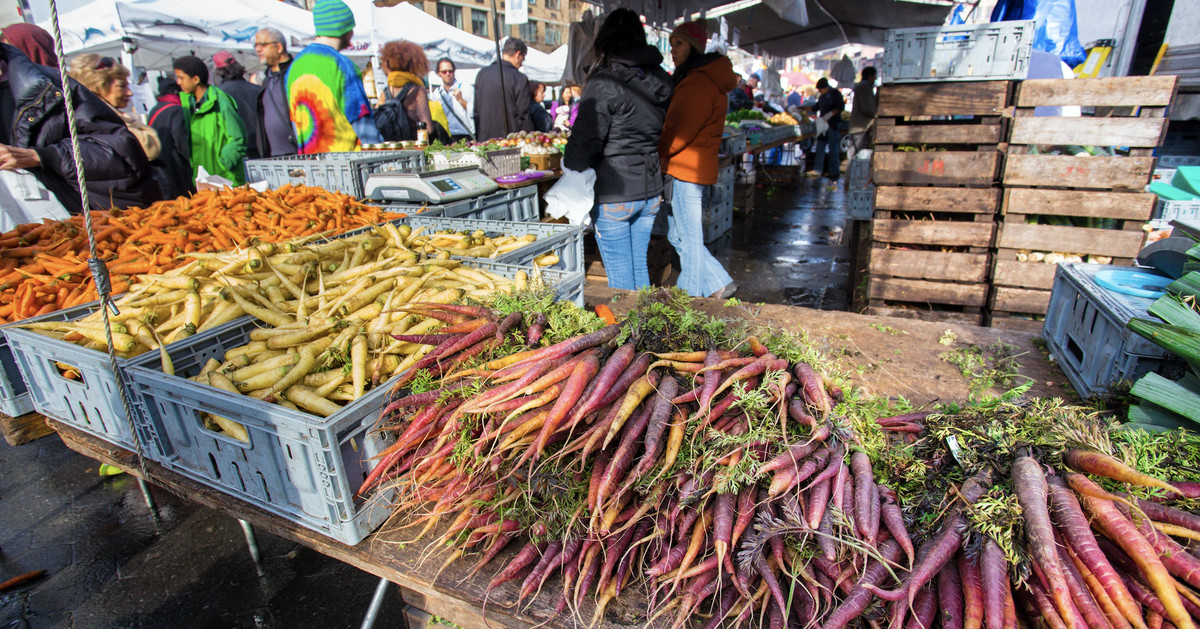How to Find Inspiration at the Farmers Market
Professional chefs all give the same advice: “Just go to the market and see what inspires you!” It’s easy for them to say: We all know the trope of the chef in the farmers market, tote bags and the occasional wagon overflowing with produce as they flit from stall to stall, strategizing the many wonderful dishes they will conjure from these raw materials. But if you, a regular citizen, have ever tried to replicate this scenario, then you’re probably familiar with the high hopes, dashed expectations, and wilted vegetable aftermath of an impulsive market trip.
Perhaps this “just get inspired!” mantra actually works in late summer when tomatoes are perfectly ripe. No one in the history of agriculture has struggled to find a way to prepare a tomato perfectly, or at least adequately. But the rest of the year, expectations usually exceed reality.
To wit: You cycle to the market on a beautiful autumn day, but upon arrival, you find none of the produce you got used to seeing all summer. So you pick up some oyster mushrooms, a butternut squash that takes up half your tote bag, and a bunch of kale. When you get home, you’re too exhausted for creativity, so you saute the mushrooms and kale. The prospect of preparing the butternut squash feels overwhelming, so it winds up sitting on your windowsill all through the winter as an incidental decoration.
The reason for this disconnect between aspiration and reality? Professional chefs are literally trained for this. Whether they trained in culinary school or on the job, they learn dozens of formulas, ratios, and techniques that serve as a perfect foundation for effortless improvisation. But luckily for the rest of us, home cooks can learn to cook creatively too.
The trick is simple: Just do a tiny bit of planning to make space for inspiration. Here are a few strategies I use to do just that:
Plan with flexibility
Make a general plan before you go to the market: Have an idea of what you want to make, but keep the specifics vague. For instance, you might want to make pasta with vegetables, herbs, and garlic butter. When you get to the market, be spontaneous with the ingredients, but stick to the plan.
Think in categories: Sometimes, you’ll go to the market without any plans to cook, but you’ll have a sense of which vegetables you need to stock up on for the week. In this case, make a list of a few categories instead of specific items. For instance, “one fruit, one starchy vegetable, and one leafy green” instead of “apples, potatoes, and kale.” If the potatoes look a little green around the gills, make a beeline for the spaghetti squash.
Stock your kitchen
Staples: Try to keep your fridge and pantry stocked with essentials. That way, if you find a good price on figs at the farmers market (semolina cake time!), you won’t have to make a separate trip to buy eggs and butter.
Flavor builders: Always try to have a couple of flavor-packed ingredients on hand (hot sauce, garlic, your favorite spice blend, olives, citrus, anchovies, tomato paste, capers, etc.), and use them to build layers of flavor. While you stroll the market, think about your collection, and consider what would pair well with the produce you encounter. For instance, you know you have garlic, lemon, and pecorino Romano at home, so you go for the Brussels sprouts. Grill them with salt and pepper, sprinkle with lemon zest and juice, and grate on the cheese.
Create a repertoire
Make a list of adaptable recipes: Write down a list of your favorite produce-forward recipes, and keep it on your phone. Spend a few minutes brainstorming other fruits and vegetables that can be substituted, so that you’ll feel comfortable thinking on your feet and adapting a recipe. For instance, you can make a blackberry cobbler with any berry or stone fruit. Use your list to plan ahead, or just give it a quick skim on your way to the market for a little inspiration.
Make a list of three easy sauces: There’s nothing like a sauce to enliven a simple salad or veggie roast, so it’s useful to have a few easy sauce recipes in your back pocket. Try to master one herby sauce, one creamy sauce, and one bright and sunny sauce. Like, for example, pesto, lemony tahini, and pico de gallo. Or green goddess, mornay, and Vietnamese nuoc mam. Or all of the above! Keep any freezable sauces (salsas, pestos) in small containers in the freezer. And keep a few staple ingredients on hand (cheese, mayo, vinegar, citrus) so you can mix up a batch anytime.
Likewise, keep a list of your favorite cooking techniques on your phone. For instance, stir fry, roast, braise, confit, saute. We all have a favorite we default to, but different techniques create different flavors and textures.
Always be learning
Follow your farmers market on social media: If you’re not deep in the gardening world, it’s totally normal not to know what’s in season at all times. While you could do a bunch of Googling, it’s a lot more fun to get a sense of what’s in season by following your local farmers market. Seasonality varies from place to place, so it’s best to follow whatever market you’ll actually shop at.
Learn new techniques and components: Whenever you make a new recipe, make a mental (or literal!) note of any techniques or components that you could borrow for a future dish. For instance, if you make a recipe for chermoula eggplant, consider which other vegetables the chermoula would pair well with. Or if you learn to make shakshuka, think about which other saucy ingredients you could poach your eggs in.
Get into gardening: Plant a little potted herb garden, help a friend out with their garden, or volunteer. A little gardening goes a long way toward feeling more in tune with seasonal produce — and, in turn, knowing what you want to buy the next time you find yourself at a farmers market.
Kathryn Pauline is the creator of the blog Cardamom and Tea. Her debut cookbook A Dish for All Seasons is forthcoming in 2022 with Chronicle Books. She grew up in Chicago and lives in Melbourne.






